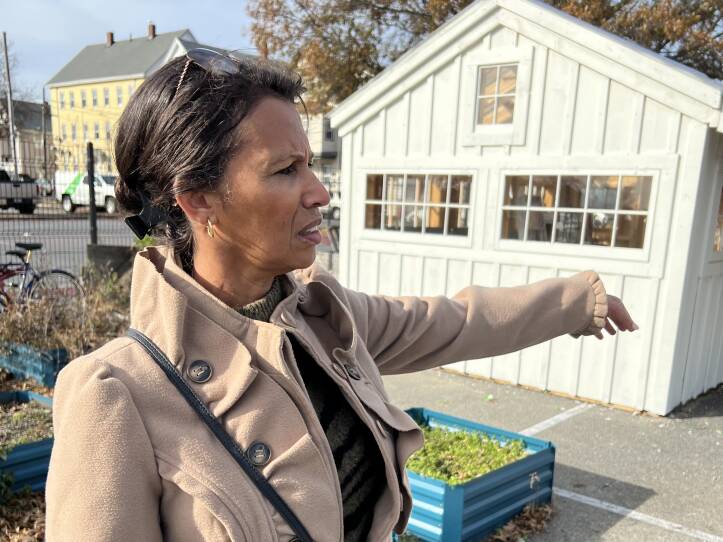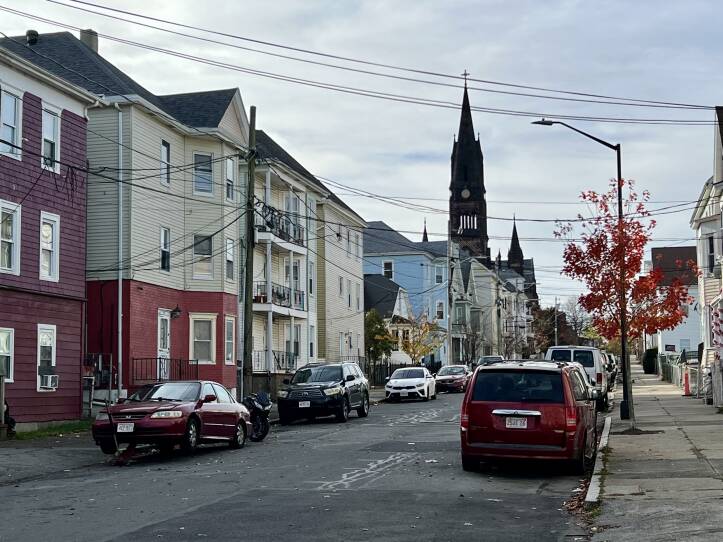Salt marshes lace much of the South Coast shoreline, but not in New Bedford. Development of the harbor displaced nearly all traces of them more than a century ago.
Now, with climate resilience in mind, the city and a nonprofit partner are building a salt marsh, from scratch, in one of New Bedford’s most densely populated neighborhoods. In the process, they’ll connect Riverside Park — and the neighborhood — to the water.
Like a big-city greenway, only smaller, Riverside Park runs for six blocks between Belleville Avenue and the Acushnet River. It has a soccer field, skate park, playground, and big community garden.
On a windy day, the city parks director, Mary Rapoza, is walking toward what’s probably the least popular thing at Riverside Park: a small, stagnant pond.
“Hi — hey, buddies,” she says, greeting a couple of ducks paddling around. The wind is rushing through tall, tasseled reeds.
“These are phragmites — and that's really where this whole story starts,” she says.
Phragmites are invasive, and they’ve grown from nothing a decade ago to easily 10 feet high. They’ve created a visual barrier, Rapoza says, “so this is why you see a lot of dumping happening here at the pond.”
A nonprofit group, Groundwork Southcoast, which helps maintain Riverside Park and runs the community garden, offered to help remove the phragmites.
When the city looked into it, experts said the pond itself shouldn’t be there.
It was built, with the park, about 20 years ago, and the designers intentionally blocked the inflow of water from the Acushnet River. This part of the river is upper New Bedford Harbor, which was, and remains, a federal Superfund site.
Rapoza said now that the U.S. Environmental Protection Agency’s work to reduce toxic polychlorinated biphenyls, or PCBs, in the riveris nearly done, the next logical step is to eliminate the pond and regrade the land to form a working salt marsh.
“A working salt marsh has many benefits,” she said. “It does create a sponge so that when the river rises, it can absorb a lot of that water, so that it's not flooding the neighborhood.”
Which means coastal resilience, too, for storms and sea level rise.
“Working salt marshes also provide habitat for fish, especially spawning fish, and also many of our native birds,” she said.
All of that beauty, and environmental value, will sit in the heart of New Bedford’s North End.
The North End has long been an immigrant neighborhood — historically Portuguese, and today, largely Central American.

Brian Pastori is deputy director of the Community Economic Development Center, which sponsors a Guatemalan festival and weekly summer food markets in Riverside Park. He said the park is a popular gathering spot.
“It's one of the few places where it's, like, Latino-dominant in the city, where it's mostly Latino families,” he said. “You're mostly hearing Spanish. It's a great asset.”
But he said right now, the neighborhood feels very separated from the water.
“It’ll be really interesting to see what develops, in terms of access to the river, right? Because the park exists on the river, but the river might as well not be there,” he said.
One spot with a good view of the river is the community garden.

One day last fall, Maria Fortes opened the garden gate to show off about 180 planting beds — all now buttoned up for the winter.
Fortes is community engagement manager at Groundwork Southcoast, the city’s nonprofit partner on the salt marsh. She also lives nearby and was a childhood immigrant from Cape Verde.
Don’t underestimate this neighborhood’s interest in the waterfront, she said.
People often think immigrants don’t have a lot of knowledge of the environment, “but in all reality, we really do,” she said. “We just didn't have the vocabulary to explain that.”

As the project moves ahead, Rapoza will go door-to-door with Groundwork Southcoast’s paid corps of local teens and young adults, known as the Green Team. They’ll let residents know what’s happening and collect suggestions and comments.
Mary Rapoza, the director of parks, said building a salt marsh represents a new kind of opportunity: “restoring the shoreline to a more natural state, more what would have been here before all the factories went in.”
New Bedford’s urban salt marsh is restoration, climate resilience, and beautification — all in one.
Copyright 2024 CAI. To see more, visit CAI.




